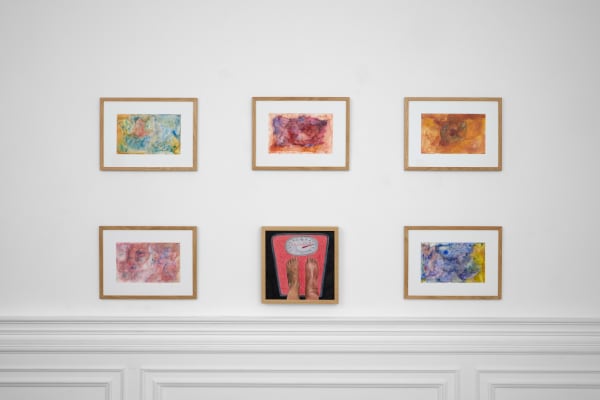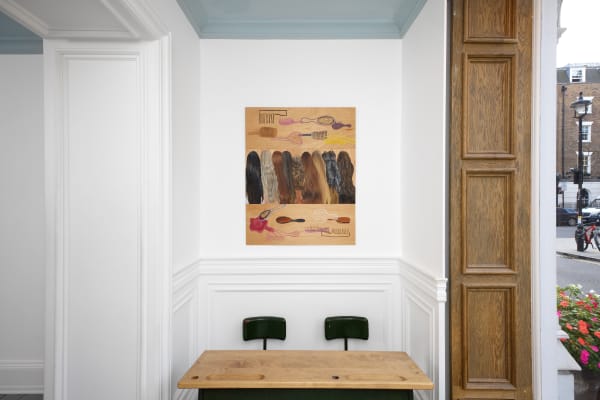Lorena Levi: Cold Hard Plastic
Through oil, watercolour, and pencil, Levi examines the collision between childhood fantasies of perfection and the harsh realities of illness. Drawing from her personal experience of ongoing cancer treatment, she uses the figure of Barbie, with her flawless body, ideal life, and complete self-sufficiency, as a measure of the impossible standards women internalise from an early age. Following renewed cultural interest in Barbie and its exploration of femininity, Levi’s work considers what happens when the myth of control meets the body’s vulnerability. The plastic world of Barbie, unchanging and problem-free, stands in stark contrast to the experience of diagnosis and chemotherapy, laying bare the gap between cultural fantasy and lived truth. Levi presents illness as more than a physical condition: it becomes a rupture, a forcible return to reality that shatters the illusion of perfection we are taught to sustain.
In Illness as Metaphor, Susan Sontag argued that ‘illness is not a metaphor, and the most truthful way of regarding illness – and the healthiest way of being ill – is one most purified of, most resistant to, metaphoric thinking.’ Her appeal for clarity, for a language unclouded by superstition or sentimentality, has long haunted artists working from experiences of bodily breakdown. Yet Levi’s paintings, made during hospital stays and in the intervals between treatments, suggest that metaphor is not an evasion but a means of surviving and translating the abstraction of medical discourse.
The exhibition opens with Locks, an oil painting on wood panel divided into three horizontal sections. The top and bottom thirds show arrays of hairbrushes – Barbie-sized, toy-like, some still tangled with clumps of hair, others crudely outlined – while the central band almost overflows with the cascading hair of nine women. Positioned at the gallery’s entrance, Locks acts as a prelude. It binds the language of girlhood grooming to the spectacle of bodily loss. What might once have been an emblem of beauty becomes an index of fragility.
In another painting, a child’s scissors are primed to cut into a doll’s blond hair; beside it, a toilet bowl cradles a dark clump of human hair ready to be flushed. The scenes are at once tender and cruel, their domestic scale amplifying their violence. Here, Barbie’s unblemished perfection – her pink gloss, her hair that never grows back – collides with the cycles of treatment and regrowth that define the artist’s own experience.
A large oil painting on wood, reminiscent of Rembrandt’s The Anatomy Lesson of Dr. Nicolaes Tulp, centres on a patient whose head has been deliberately cropped from view. Around her, doctors lean in, their faces vivid and animated. By withholding the patient’s face, Levi makes visible the asymmetry of care – the way the clinical gaze transforms the sick body into a site of study rather than a reflection of self. The painting’s power lies in this refusal of redemptive sentiment; it captures not recovery, but the quiet indignity of being seen without being recognised.
Downstairs, a progression of paintings moves from stylised Barbie pinks to the muted, fleshy tones of self-portrait. Opposite, five bruise-coloured watercolours depict the sky as seen from a hospital bed, punctuated only by a small painting of two feet – one swollen – on a bathroom scale whose digital display reads ‘concerned’ in Barbie’s cursive font. Each sky is framed as though glimpsed from the hospital bed itself, appearing as a sequence of fragile hopes, their delicacy feeling hard-won.
Finally, three pencil portraits of Levi’s doctors hang high on the wall in gilded artist-made frames. Positioned like secular putti, they hover over the viewer, benevolent yet remote. The gesture feels reverent rather than critical: an act of gratitude tempered by dependence. Drawn with precision and care, these portraits reflect the complex intimacy between patient and physician – a relationship shaped as much by vulnerability as by trust.
If Frida Kahlo transformed the hospital bed into a theatre of myth and Tracey Emin made confession a mode of endurance, Lorena Levi continues this lineage, using painting as a means of negotiating the limits of the body and the image alike. Against Sontag’s prescription, she does not strip illness of metaphor; she reclaims it as a language of understanding, capable of holding pain without sanctifying it. In Cold Hard Plastic, the doll, the doctor, and the patient become participants in the same uneasy system of care. What endures is not necessarily catharsis, but it is lucidity – the recognition that to look, to paint, and to persist is itself a form of survival.





